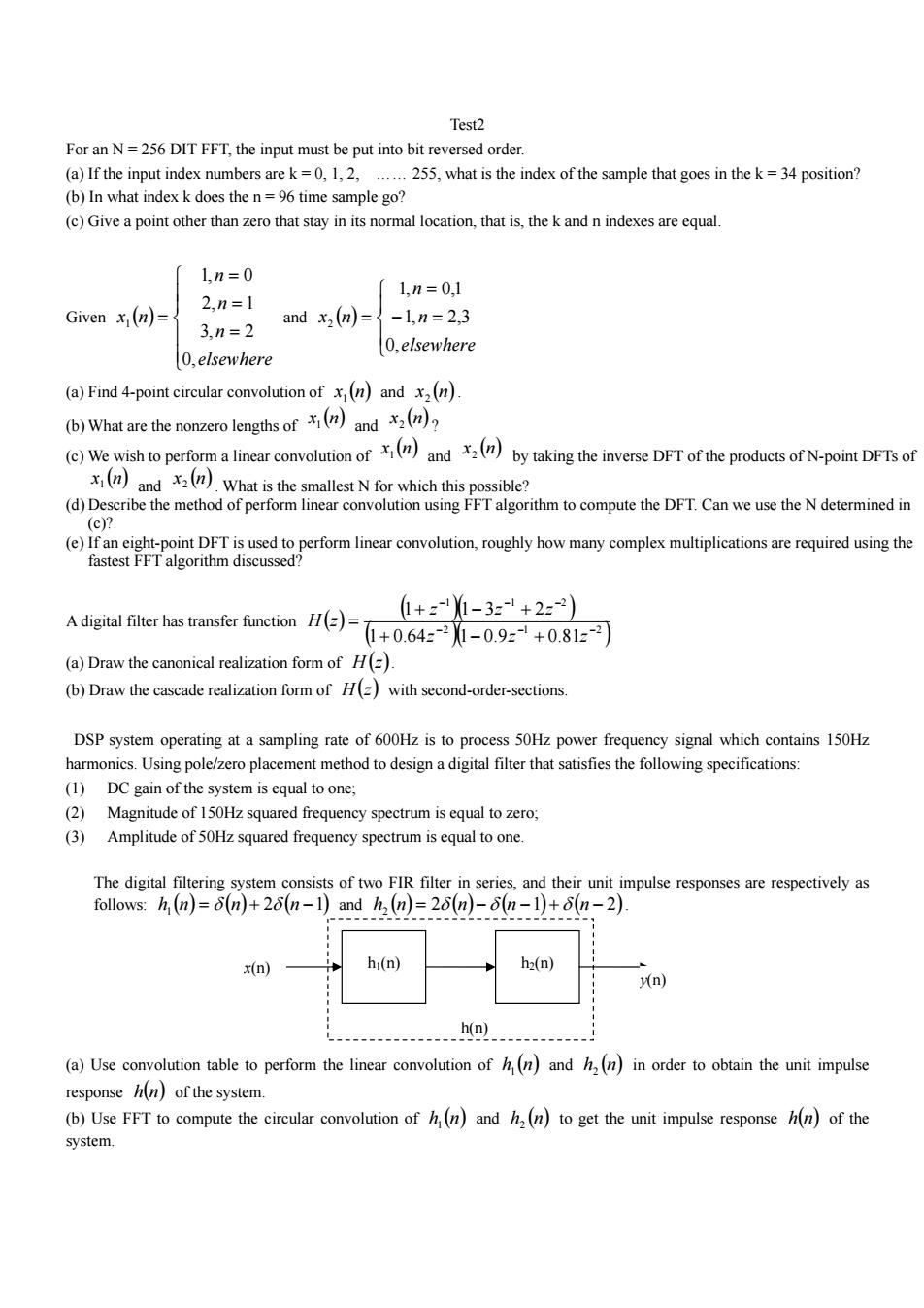正在加载图片...

Test2 For an N=256 DIT FFT,the input must be put into bit reversed order. (a)If the input index numbers are k=0,1,2,.....255,what is the index of the sample that goes in the k=34 position? (b)In what index k does the n=96 time sample go? (c)Give a point other than zero that stay in its normal location,that is,the k and n indexes are equal. 1n=0 1,n=0,1 2,n=1 Given x(n)= and x2 (n)= -1,n=2,3 3,n=2 0,elsewhere 0,elsewhere (a)Find 4-point circular convolution ofx(n)and x,(n) (b)What are the nonzero lengths ofand ()We wishto prformainar onvoution ofandby taking the inverse DFT of the products of N-point DFTs of and.What is the smallest N for which this possible? (d)Describe the method of perform linear convolution using FFT algorithm to compute the DFT.Can we use the N determined in (c)? (e)If an eight-point DFT is used to perform linear convolution,roughly how many complex multiplications are required using the fastest FFT algorithm discussed? Adigital filter has transfer function (1+z-%-3z+2z2) 1+0.64z-21-0.9z+0.8122)) (a)Draw the canonical realization form of H(). (b)Draw the cascade realization form of H(with second-order-sections. DSP system operating at a sampling rate of 600Hz is to process 50Hz power frequency signal which contains 150Hz harmonics.Using pole/zero placement method to design a digital filter that satisfies the following specifications: (1)DC gain of the system is equal to one; (2)Magnitude of 150Hz squared frequency spectrum is equal to zero; (3) Amplitude of 50Hz squared frequency spectrum is equal to one. The digital filtering system consists of two FIR filter in series,and their unit impulse responses are respectively as follows:h (n)=6(n)+26(n-1)and h,(n)=26(n)-6(n-1)+6(n-2). x(n) hi(n) h2(n) wn) h(n) (a)Use convolution table to perform the linear convolution ofn)and h(n)in order to obtain the unit impulse response h(n)of the system. (b)Use FFT to compute the circular convolution of (n)and h(n)to get the unit impulse response h(n)of the systemTest2 For an N = 256 DIT FFT, the input must be put into bit reversed order. (a) If the input index numbers are k = 0, 1, 2, …… 255, what is the index of the sample that goes in the k = 34 position? (b) In what index k does the n = 96 time sample go? (c) Give a point other than zero that stay in its normal location, that is, the k and n indexes are equal. Given elsewhere n n n x n 0, 3, 2 2, 1 1, 0 1 and elsewhere n n x n 0, 1, 2,3 1, 0,1 2 (a) Find 4-point circular convolution of x n 1 and x n 2 . (b) What are the nonzero lengths of x n 1 and x n 2 ? (c) We wish to perform a linear convolution of x n 1 and x n 2 by taking the inverse DFT of the products of N-point DFTs of x n 1 and x n 2 . What is the smallest N for which this possible? (d) Describe the method of perform linear convolution using FFT algorithm to compute the DFT. Can we use the N determined in (c)? (e) If an eight-point DFT is used to perform linear convolution, roughly how many complex multiplications are required using the fastest FFT algorithm discussed? A digital filter has transfer function 2 1 2 1 1 2 1 0.64 1 0.9 0.81 1 1 3 2 z z z z z z H z (a) Draw the canonical realization form of H z . (b) Draw the cascade realization form of H z with second-order-sections. DSP system operating at a sampling rate of 600Hz is to process 50Hz power frequency signal which contains 150Hz harmonics. Using pole/zero placement method to design a digital filter that satisfies the following specifications: (1) DC gain of the system is equal to one; (2) Magnitude of 150Hz squared frequency spectrum is equal to zero; (3) Amplitude of 50Hz squared frequency spectrum is equal to one. The digital filtering system consists of two FIR filter in series, and their unit impulse responses are respectively as follows: 2 1 h1 n n n and 2 1 2 h2 n n n n . (a) Use convolution table to perform the linear convolution of h n 1 and h n 2 in order to obtain the unit impulse response h n of the system. (b) Use FFT to compute the circular convolution of h n 1 and h n 2 to get the unit impulse response hn of the system. h1(n) h2(n) x(n) h(n) y(n)